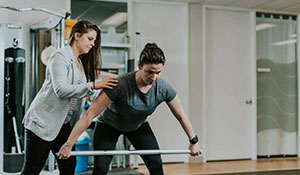Common Crossfit Injuries
Unpacking CrossFit: Navigating the Common Injuries with Insights from a Physiotherapist
CrossFit has surged in popularity over the years, attracting fitness enthusiasts with its high-intensity workouts and community-driven approach. However, like any intense physical activity, CrossFit comes with its fair share of risks. In this blog, we’ll delve into some common injuries associated with CrossFit.

1. Rotator Cuff Strains and Tears:
Physiotherapy journals consistently report that injuries to the rotator cuff are prevalent among CrossFit participants. The dynamic and repetitive nature of CrossFit exercises, particularly those involving overhead movements like snatches and overhead presses, can lead to overuse and strain on the shoulder’s rotator cuff muscles. Studies suggest that improper form and excessive loading contribute significantly to these injuries.
2. Lower Back Pain and Strains:
CrossFit’s emphasis on functional movements and heavy lifting can also take a toll on the lower back. Physiotherapy journals highlight that high-impact exercises, such as deadlifts and cleans, can lead to lower back pain and strains if performed incorrectly or with improper form. Statistics indicate that a considerable number of CrossFit-related injuries involve the lumbar spine region.
3. Patellar Tendonitis:
The explosive and dynamic nature of movements like box jumps and heavy squats can contribute to patellar tendonitis, a condition where the tendon connecting the kneecap to the shin becomes inflamed. Physiotherapy research underscores the importance of proper warm-up, technique, and progressive loading to mitigate the risk of developing this painful knee injury.
4. Achilles Tendon Issues:
Physiotherapy journals reveal that Achilles tendon problems are not uncommon in CrossFit participants, particularly due to the frequent inclusion of activities like double-unders, box jumps, and sprinting. The strain from these activities, combined with inadequate rest and recovery, can lead to overuse injuries affecting the Achilles tendon.

While not a specific injury, rhabdomyolysis is a serious condition that can result from extreme exertion, commonly associated with high-intensity workouts like those in CrossFit. Physiotherapy literature stresses the importance of recognizing the symptoms of rhabdomyolysis, such as severe muscle pain, swelling, and dark urine, as prompt medical attention is crucial in such cases.
While CrossFit offers a dynamic and engaging approach to fitness, it’s essential for participants to be aware of the potential risks and take necessary precautions like any sport or activity. Physiotherapy journals provide valuable insights into the common injuries associated with CrossFit, emphasizing the significance of proper form, progressive training, and adequate recovery to minimize the likelihood of injuries and ensure a sustainable fitness journey. As with any physical activity, consulting with healthcare professionals and qualified trainers is crucial for a safe and effective CrossFit experience. If you have any questions or concerns around your training, don’t hesitate to reach out!
Happy lifting!



